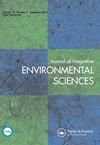Individual-Based Model use in Marine Policy
IF 3.5
4区 环境科学与生态学
Q3 ENVIRONMENTAL SCIENCES
Journal of Integrative Environmental Sciences
Pub Date : 2023-11-03
DOI:10.1080/1943815x.2023.2271550
引用次数: 0
Abstract
Individual-based models (IBMs) are increasingly used in marine conservation research, making this is an ideal time to assess IBM use in marine policy. IBMs can contribute important information to marine management and policy questions, as they offer complex methods of understanding ecosystems and animal behaviour, by allowing for heterogeneity in both individuals and environments. A review of 108 international peer-review publications utilizing marine IBMs was conducted using Web of Science (WoS). It was determined that 55% of the WoS articles claimed that the IBMs were relevant or important to marine conservation policy or management. A relevant English-language policy document was located for 83% of the IBMs, but only 32% were cited, while 85% of the same policy documents cited a different, non-IBM, modelling method. A separate survey of 175 policy documents from the Government of Canada was conducted. Of the 60 that contained citations, zero documents cited an IBM, while 75% cited a different modelling method. Of 407 webpages reviewed from the National Oceanic and Atmospheric Administration, the New Zealand Department of Conservation, and the UK Government website, only 4% referenced IBMs. This research demonstrates that, despite claims of usefulness by researchers, IBMs are not used to inform policy, while other model methods are commonly cited. Modellers should not assume that their model will inherently be useful for policy and should instead ensure that they are: 1) addressing a policy need; and 2) making the information accessible to policymakers by crafting a communication plan and/or joining a relevant boundary organization.以个人为本的模式在海洋政策中的应用
基于个体的模型(IBM)越来越多地用于海洋保护研究,因此现在是评估IBM在海洋政策中的应用的理想时机。ibm可以为海洋管理和政策问题提供重要信息,因为它们提供了理解生态系统和动物行为的复杂方法,允许个体和环境的异质性。利用Web of Science (WoS)对108篇利用海洋ibm的国际同行评议出版物进行了审查。经确定,55%的WoS文章声称ibm与海洋保育政策或管理有关或重要。83%的ibm找到了相关的英语政策文件,但只有32%被引用,而85%的相同政策文件引用了不同的非ibm建模方法。对加拿大政府的175份政策文件进行了单独调查。在包含引用的60个文档中,没有文档引用了IBM,而75%的文档引用了不同的建模方法。在来自国家海洋和大气管理局、新西兰环境保护部和英国政府网站的407个网页中,只有4%的网页提到了ibm。这项研究表明,尽管研究人员声称有用,但ibm并没有被用来为政策提供信息,而其他模型方法通常被引用。建模者不应该假设他们的模型本质上对政策有用,而应该确保他们是:1)处理政策需要;2)通过制定沟通计划和/或加入相关的边界组织,使决策者能够获得信息。
本文章由计算机程序翻译,如有差异,请以英文原文为准。
求助全文
约1分钟内获得全文
求助全文
来源期刊

Journal of Integrative Environmental Sciences
ENVIRONMENTAL SCIENCES-
CiteScore
3.90
自引率
0.00%
发文量
13
审稿时长
>12 weeks
期刊介绍:
Journal of Integrative Environmental Sciences (JIES) provides a stimulating, informative and critical forum for intellectual debate on significant environmental issues. It brings together perspectives from a wide range of disciplines and methodologies in both the social and natural sciences in an effort to develop integrative knowledge about the processes responsible for environmental change. The Journal is especially concerned with the relationships between science, society and policy and one of its key aims is to advance understanding of the theory and practice of sustainable development.
 求助内容:
求助内容: 应助结果提醒方式:
应助结果提醒方式:


